Can system increase production to make up for reduction in grow-out acreage?
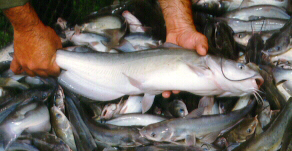
Multiple-batch production systems have for many years been the norm for the production of channel catfish (Ictalurus punctatus) in the U.S. states of Alabama, Arkansas, Louisiana, and Mississippi. Under these systems, 12.7-cm fingerlings are restocked annually at a rate that takes into account an average mortality projected over the 18 to 24 months needed to grow out the fish. Multiple-batch production produces 450- to 680-gram fish fairly efficiently to an average yield of 4,482 to 5,604 kilogram per hectare (Tucker et al. 1992).
However, two things changed in the past few years. First, the farm-bank price of catfish decreased from U.S. $1.54 to 1.65 per kilogram to $1.15 to 1.28 per kilogram. The cost of producing catfish is thought to range U.S. $1.32 to 1.54 per kilogram. As a result, farmers are losing money, and some operations are going out of business. Secondly, the size of catfish desired by processors has increased to the 681- to 908-gram range.
Improved production needed
Catfish producers are faced with management schemes that no longer accomplish growth at a consistently profitable level. The extra time and inputs required to produce the larger-size food fish has reduced the profitability of the multiple-batch production system.
Engle (2001) estimated there is a 99 percent probability of producing market-size fish at less than U.S. $1.32 per kilogram when fingerlings of about 17.8 cm are stocked into grow-out ponds. But given that most fish producers have ready access to or grow their own 12.7-cm fingerlings, and fingerlings longer than 15 cm are typically hard to find and transport great distances, a production system utilizing the 12.7-cm stock to reliably grow food fish to larger sizes is needed.
Modular system
One alternative approach is the three-step modular system outlined below. Operations that purchase 12.7-cm fingerlings would go directly to step 2 to apply the system.
- In the April-June hatching period, fry are stocked at rates of 296,400 per hectare to grow 10.2- to 12.7-cm fingerlings by the end of the first season. Fish can be fed at rates up to 135 kilograms per hectare per day. Some days of feeding in the fall are typically skipped as the small fingerlings encounter enteric septicemia of catfish.
- At the end of the first season or by start of the subsequent spring, the 10.2- to 12.7-cm fingerlings are placed in “stocker” ponds at the rate of 98,800-123,500 per hectare. These fingerlings are fed all the feed they will consume and provided with aeration at rates of 7.5 horsepower per hectare. In this phase, fish growth is rapid and will usually yield a standing crop of 17.8-to 20.3-cm stocker-size fish totaling 11,200, kilograms per hectare at the end of the second growing season.
- At the end of the second season or by the start of the second subsequent spring, the 17.8- to 20.3-cm stockers are placed in final grow-out ponds at rates of 9,880-14,820 fish per hectare, depending on the production goal and size needed for market. In this final stage, maximum feeding rates near 168 kilograms per hectare per day are normal, with 5 horsepower per hectare of paddlewheel aeration recommended.
System comparison
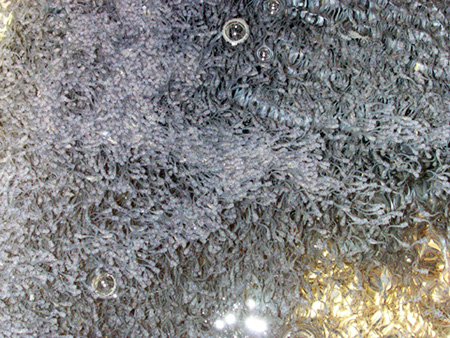
A project compared the modular production system to the multiple-batch catfish production system currently in use in the delta region of Mississippi. Production parameters came from enterprise budget preparations that stemmed from long-term analyses of catfish production systems in the delta. Modular production system results came from farmers presently using the system.
Farm size, production costs, fixed costs, machinery, and equipment were all taken into account. Enterprise budgets were constructed for each scenario and compared. Break-even analysis was conducted to determine the cost of production for each system. The break-even costs can be compared to current farm-bank prices to determine each system’s profitability.
Results
Total farm acreage for the two compared systems did not vary, though area usage by specific production phases did (Table 1). There were about 425 grow-out ha in the multiple-batch production system, compared to 365 in the modular production system – a 60-hectare reduction for the modular system. This poses the question whether the modular system can increase production to make up for this reduction in grow-out acreage. Additionally, in this analysis, all operating costs for 81 hectare of “fingerling-to-stocker” production were accounted for in the modular economic analysis.
The top portion of Table 1 presents the change in fingerling stocking rates for each system and the associated costs. The middle portion presents the differences in production costs of food-size catfish produced by each production system and the bottom presents the break-even costs of production for each system.
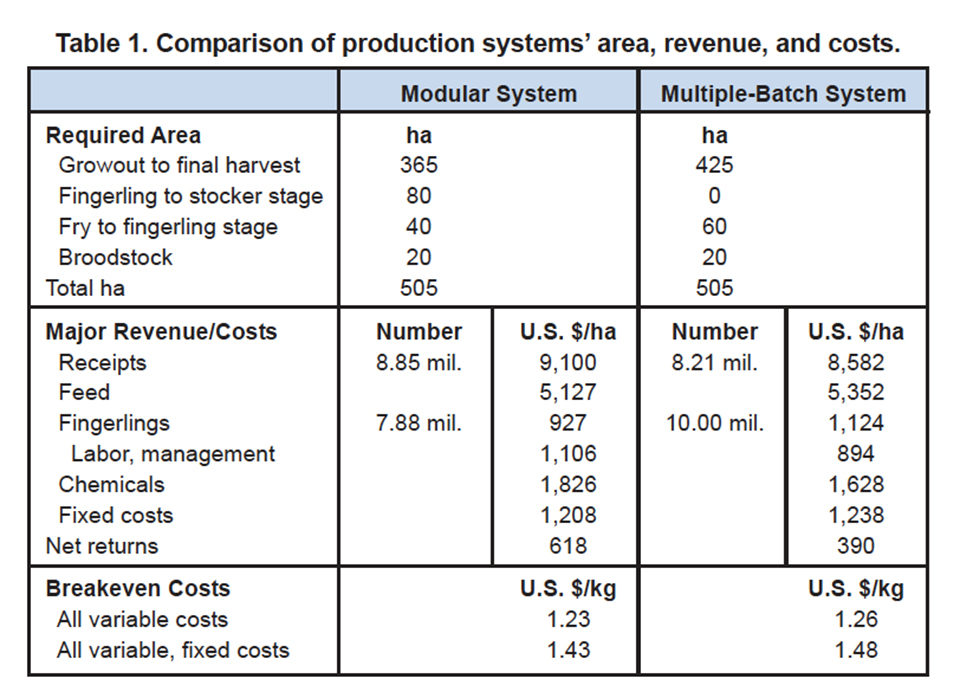
Other variable costs
Other variable costs were estimated for each system. Feed requirements for the two systems differed, with the multiple-batch system requiring about 14.72 metric tons (MT) feed per hectare per year compared to 14.60 MT per hectare per year for the modular system, reflecting a decrease of U.S. $32.69 per hectare per year in feed costs.
The modular production system required an additional four seining crew employees over the multiple-batch production system, for an additional U.S. $72,000 per year in labor and management costs. Since less area required salt and diuron applications for the modular system, these costs were reduced. Copper sulfate was applied to 20 more ha in the modular system, resulting in a higher charge for this chemical. Overall, chemical costs were about $24.70 hectare per year higher for the multiple-batch system than the modular system.
Equipment usage for the two production systems followed the same rules of 1 tractor and power takeoff emergency aerator per 3 ponds and 2 10-hp electric aerators per 4.05 hectare pond. The modular system required two boom-loading trucks, whereas the multiple-batch system required only one.
Net returns
When all receipts and costs were totaled, the modular system had a net annual return of U.S. $617.50 per hectare, compared to the multiple-batch system’s net return of $390 per hectare, a difference of $227.50 per hectare. The break-even price of production is presented in Table 1.
The modular production system had a U.S. $0.02 per kilogram per lower cost than the multiple-batch system when variable costs only were considered. When both variable and fixed costs were included, the modular system had a $0.04 per kilogram lower break-even cost. That is good, but other “noncash” advantages of the modular system may be just as important.
Control and efficiency
The three-step modular catfish production system, originally propos-ed many years ago (Snow, 1976), is currently in use on a small number of farms in the Mississippi delta. Ponds are still harvested several times during a year. A small amount of overlap in fish crops is expected in the modular system. For most of the growing period, a single crop of fish is present in the final grow-out pond, but as restocking typically occurs each spring, a portion of the previous crop may still remain to be harvested for up to four months.
The economic analysis showed an increased net return for the modular system. All growers contacted that use the system said they were very satisfied with its level of production. Other noncash but important reasons to pursue the modular production system include the additional control over catfish at all stages, reduced risk of overstocked or understocked ponds, earlier awareness of dead fish in the production cycle, and a more efficient use of pond space and size control.
The advent of genetically improved catfish strains that show improved growth over traditional catfish may still result in some modification of this system. Changes in the size of fish required by processors may also change stocking practices.
Given the current size of catfish fingerlings that are widely available and needs of processors, the modular system has proven to work well. Growth of 12.7-cm fingerlings to stockers in their second year takes advantage of the natural competitive nature of the fish at this size. Fish feed very aggressively when stocked appropriately for the second year of growth.
Stocker-size fish should be produced as close to the final grow-out ponds as possible to keep transport costs to a minimum. At many operations, this distance can be kept to 1.6 km or less. At the same time, fry-to-fingerling ponds should be located in areas where close observation is possible, because these fish are highly susceptible to bird predation and require more attention to assure survival than those in stocker or grow-out ponds.
Conclusion
Alternative production systems should be considered in changing economic times and times of changes in fish size required by processors. Farm simulations can assist farmers in determining if another production system, such as the modular system, is right for them.
The delta region of Mississippi, USA, has a few producers who are using the three-step modular system successfully. This type of system best lends itself to operations of greater than 120 ha in size that have on-farm crews for harvesting. While the modular system does not entirely confront the current price of fish received by producers, it does decrease the potential variability in fish yields and allows greater control of pond production, which from egg to current processing size can take 30-34 months.
Note: Cited references are available from the authors.
(Editor’s Note: This article was originally published in the August 2003 print edition of the Global Aquaculture Advocate.)
Now that you've reached the end of the article ...
… please consider supporting GSA’s mission to advance responsible seafood practices through education, advocacy and third-party assurances. The Advocate aims to document the evolution of responsible seafood practices and share the expansive knowledge of our vast network of contributors.
By becoming a Global Seafood Alliance member, you’re ensuring that all of the pre-competitive work we do through member benefits, resources and events can continue. Individual membership costs just $50 a year.
Not a GSA member? Join us.
Authors
-
Terry Hanson, Ph.D.
Mississippi State University
Department of Agricultural Economics
P.O. Box 5187
Mississippi State, Mississippi
39762 USA[117,100,101,46,101,116,97,116,115,115,109,46,110,111,99,101,103,97,64,110,111,115,110,97,104]
-
Jim Steeby, Ph.D.
National Warmwater Aquaculture Center
Belzoni, Mississippi, USA
Tagged With
Related Posts
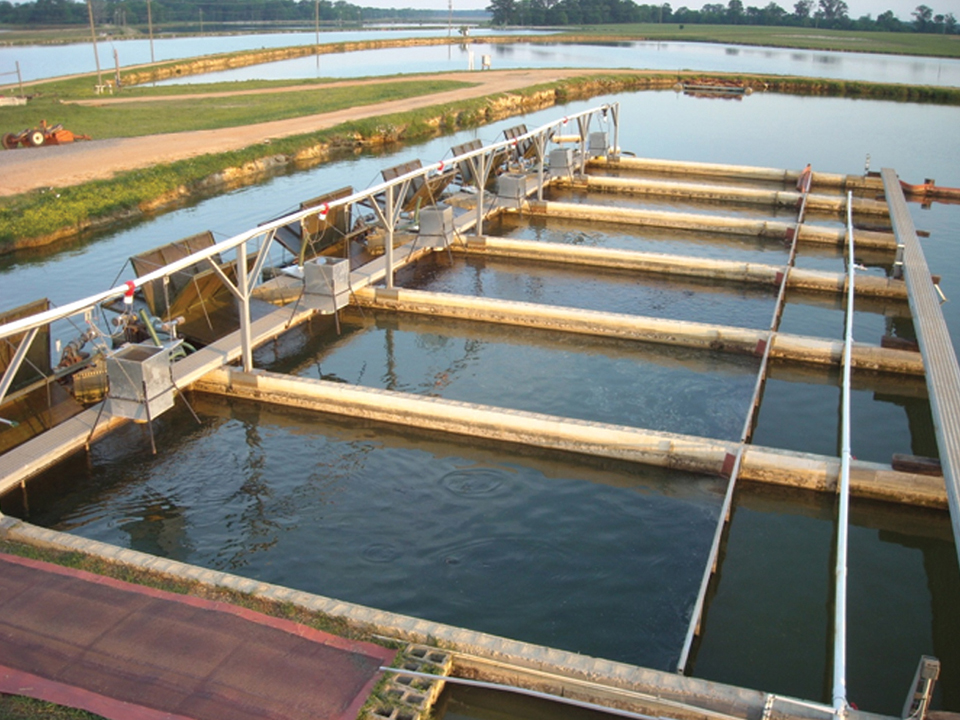
Responsibility
In-pond raceway system demonstrates economic benefits for catfish production
Auburn University researched how to improve economic efficiency and profitability of catfish production with in-pond raceway systems. IPRS systems help achieve high levels of feed performance and fish survival, and lower production costs.

Health & Welfare
Modular advantages for catfish production
Modular production of channel catfish offers better inventory control, takes advantage of early-age growth rates and reduces harvest-size variation.

Intelligence
Pond production practices linked to yellow coloration in catfish fillets
The yellow coloration in catfish fillets caused by carotenoids does not affect flavor, but many consumers see the yellowish fillets as inferior.
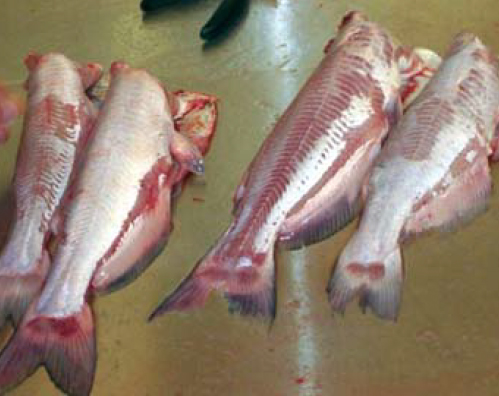
Intelligence
Reducing dockages at catfish plants
A survey found that catfish farmers lost about 2.5 percent of their product value to processing plant dockages. Out-of-size catfish represented the greatest losses.


